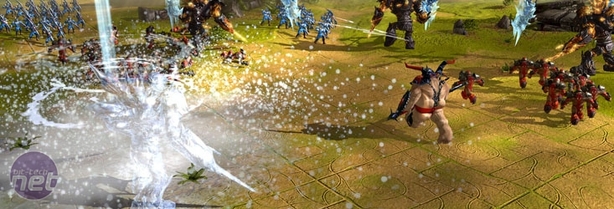
Battleforge Hands-On Preview
Publisher: Electronic ArtsPlatform: PC exclusive
Expected Release: TBA
Specific generalisations never really work, so while it’s perhaps apt to say that we at the bit-tech offices are pretty geeky people (and proud of it) you definitely can’t infer all the usual stereotypes from that. None of us wear anoraks, for example. Only one of us wears glasses – and even then with some atrociously expensive frames.
And none of us have ever played a collectable card game either, which made Battleforge a bit hard for us to get our heads around, if we’re honest.
The idea and appeal of trading the cards is something we quickly got to grips with, but how and why it could be successfully transferred to a computer game is another matter altogether.
Once it was explained to us though, we have to admit that there was a gentle rise of begrudging respect for how the two totally different types of games – tabletop and computer – could be merged. Taking card games into an online-only RTS setting on a computer is both a great way to engage and protect fans, as well as thwart piracy.
This is essentially what Battleforge is then; a witch's brew made from the clever ideas of other games, stirred together and gloated over by those egregiously ingenious German developers who base themselves out of Ingelheim.
A handful of Magic: The Gathering, a dozen spoonfuls of Command & Conquer, a pinch of the MMO online-authentication system, a shake of microtransactions and player-trading and a pinch of the co-op gameplay so excellently revived by Left 4 Dead and there you have it. Battleforge; an online strategy game with card-based gameplay and a strong focus on community.
Throw in the fact that there’s absolutely no subscriptions and it all starts sounding a bit too good to be true, but from what we’ve seen it isn’t. It’s just good enough to be true.
Microtransactions are a fairly sticky point for PC gamers though and it’s here that Battleforge perhaps faces its biggest hurdle. Like a real-life card-based game, Battleforge stands to turn a significant profit from selling booster packs to players - booster packs you’ll have to either buy or trade for if you want to stay on top of your game.
We’ll get into the depths and complexities of how card-driven the game is later on, but suffice it to say for now that the cards you have in your account represent what units and abilities you can use in game. When you buy the game you get 50 cards to start with, but there are new cards constantly coming out.
There are two basic ways to get hold of cards – you either buy a booster pack that offers a collection of different, random units and abilities, or you trade cards directly using the in-game systems. According to EA Phenomic a booster pack will cost just over £2 GBP (and the retail game comes with credit to buy your first packs) and will contain eight cards – five common, two semi-precious and one rare. One in six cards will be an ultra-rare card too.
So, it isn’t really all that expensive (definitely less expensive than real card-collecting), but the more important thing to bear in mind about this microtransaction system is that it incentivises EA Phenomic to continually re-balance and expand the game for players. It allows Battleforge to be more like an MMO – constantly evolving in response to player tactics and exploits and, in that way, it could be the most exciting thing to happen to RTS games in a long, long time.

MSI MPG Velox 100R Chassis Review
October 14 2021 | 15:04











Want to comment? Please log in.